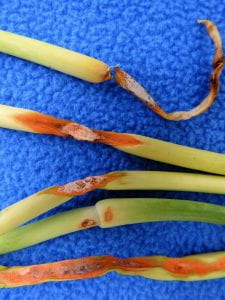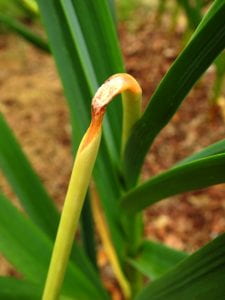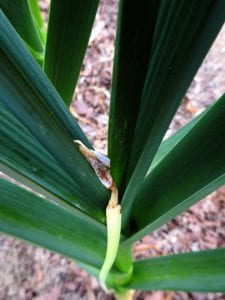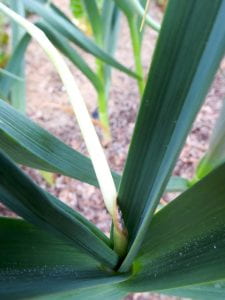This disease only affects garlic scapes and bulbils. Symptoms are sunken lesions that are initially tan, turning orange as the fungal pathogen produces spores when it is humid or rainy. Lesions can be up to an inch long and cause affected scape to twist and become girdled and collapse. Small lesions develop on bulbils. They can be a source of the pathogen when used for propagation.
Symptoms were first observed on Long Island mid-June 2020 in a commercial planting and a garden. Spores are dispersed by splashing water. Although rainfall had been very limited while scapes were growing in 2020, it had been humid overnight and both plantings were being irrigated overhead. Leaf wetness for 12 hours is considered sufficient for infection, but much longer is ideal for a major outbreak. Irrigation water could collect in the whorl where scapes emerge providing localized highly favorable conditions. Some symptoms were observed at the base of the scape; symptoms elsewhere on the scape may be tissue that was in the whorl at the time of infection. On the other hand, disease development is favored by warm temperatures (77-86 F) and it was warmer than usual during June 2020.
Anthracnose was first reported in Upstate New York (near Rochester) in 2015 and 2016. Subsequently there have been a few additional reports from Upstate New York, from New England, and elsewhere. When found in Indiana in 2019, about 50% of scapes were affected.
The pathogen, Colletotrichum fioriniae, has a broad host range. It also causes anthracnose on celery and cherry tomato, bitter rot on pear and post-harvest decay on apple. Symptoms of celery anthracnose (aka leaf curl) were observed in the garden the previous year. Other hosts reported include blueberry, strawberry, and several weeds. Weeds are particularly problematic in the disease cycle because they can be infected without visible symptoms and several are susceptible, including common lambsquarters, redroot pigweed, yellow nutsedge, oakleaf goosefoot, common groundsel, and poison ivy.
It can survive on crop debris in soil for a few years, therefore it is worthwhile to remove diseased scapes and locate future plantings away from previous plantings of susceptible crops. Also manage weeds.






